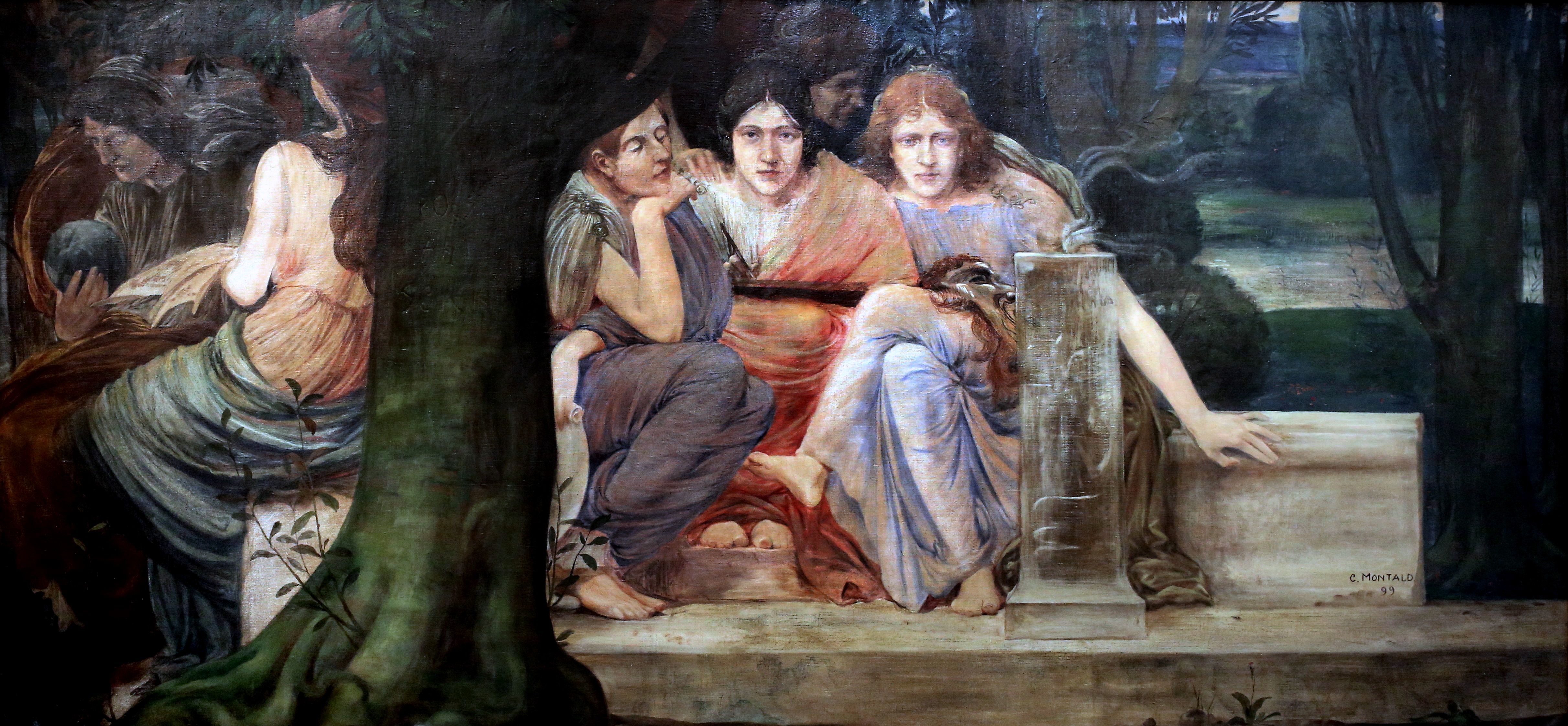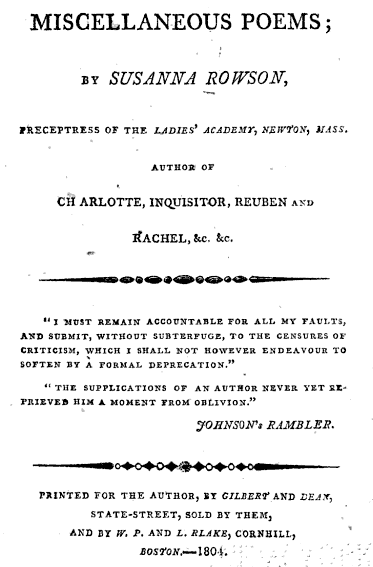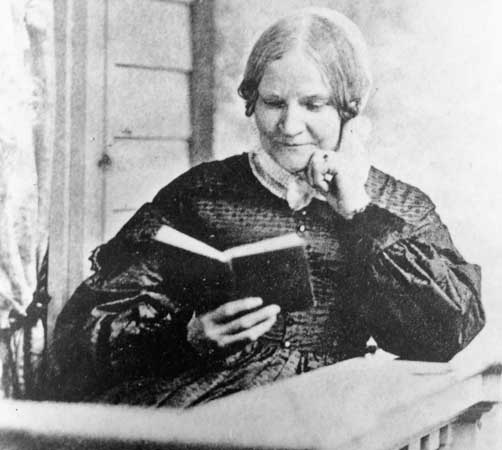|
Seduction Novel
The seduction novel is a literary genre which was popular in the late 18th and early 19th centuries. A seduction novel presents the story of a virtuous, but helpless woman who is seduced by a man that will eventually betray her. "Inevitably, she yields herself to him; inevitably, she dies." Her failure to adhere to the commonly accepted standard of sexual behaviour leads to her "self-destruction and death".H.Jacobs, Incidents in the Life of a Slave Girl. Ed. J.F.Yellin, Cambridge 2000, p. xxxii. Examples include ''Charlotte Temple'' by Susanna Rowson (1791), ''The Coquette'' by Hannah Webster Foster (1797), and the short story ''The Quadroons'' by Lydia Maria Child (1842). Harriet Jacobs's autobiography ''Incidents in the Life of a Slave Girl ''Incidents in the Life of a Slave Girl, written by herself'' is an autobiography by Harriet Jacobs, a mother and fugitive slave, published in 1861 by L. Maria Child, who edited the book for its author. Jacobs used the pseudonym Linda Brent. ... [...More Info...] [...Related Items...] OR: [Wikipedia] [Google] [Baidu] |
Rowson - Charlotte Temple, P
Rowson is a surname. Notable people with the surname include: *David Rowson (born 1976), Scottish footballer * Guy Rowson (1883–1937), English politician * James Rowson (born 1976), American baseball player and coach *Jonathan Rowson (born 1977), Scottish chess grandmaster and writer *Leslie Rowson (1903–1977), English cinematographer *Martin Rowson Martin Rowson ( ; born 15 February 1959) is a British editorial cartoonist and writer. His genre is political satire and his style is scathing and graphic. He characterises his work as "visual journalism". His cartoons appear frequently in ''The ... (born 1959), English cartoonist and writer * Susanna Rowson (1762–1824), British-American writer, poet, and playwright {{surname ... [...More Info...] [...Related Items...] OR: [Wikipedia] [Google] [Baidu] |
Literary Genre
A literary genre is a category of literature. Genres may be determined by literary technique, tone, content, or length (especially for fiction). They generally move from more abstract, encompassing classes, which are then further sub-divided into more concrete distinctions. The distinctions between genres and categories are flexible and loosely defined, and even the rules designating genres change over time and are fairly unstable. Genres can all be in the form of prose or poetry. Additionally, a genre such as satire, allegory or pastoral might appear in any of the above, not only as a subgenre (see below), but as a mixture of genres. Finally, they are defined by the general cultural movement of the historical period in which they were composed. History of genres Aristotle The concept of genre began in the works of Aristotle, who applied biological concepts to the classification of literary genres, or, as he called them, "species" (eidē). These classifications are mainl ... [...More Info...] [...Related Items...] OR: [Wikipedia] [Google] [Baidu] |
Charlotte Temple
''Charlotte Temple'' is a novel by British-American author Susanna Rowson, originally published in England in 1791 under the title ''Charlotte, A Tale of Truth''. It tells the story of a schoolgirl, Charlotte Temple, who is seduced by a British officer and brought to America, where she is abandoned, pregnant, sick and in poverty. The first American edition was published in 1794 and the novel became a bestseller. It has gone through over 200 American editions. Late in life, the author wrote a sequel that was published posthumously. Synopsis The book relates the tale of Charlotte Temple, who is enticed by a dashing soldier, John Montraville, to run away with him, but after they cross to America, he abandons her. It belongs to the seduction novel genre popular in early American literature. The novel opens upon an unexpected encounter between the British Lieutenant Montraville and Charlotte Temple, a tall, elegant girl of 15. Montraville sets his mind on seducing Charlotte and suc ... [...More Info...] [...Related Items...] OR: [Wikipedia] [Google] [Baidu] |
Susanna Rowson
Susanna Rowson, née Haswell (1762 – 2 March 1824) was an American novelist, poet, playwright, religious writer, stage actress, and educator, considered the first woman geographer and supporter of female education. She also wrote against slavery. Rowson was the author of the 1791 novel '' Charlotte Temple'', the most popular best-seller in American literature until Harriet Beecher Stowe's ''Uncle Tom's Cabin'' was published serially in 1851-1852 and authored the first human geography textbook ''Rowson's Abridgement of Universal Geography'' in 1805. Biography Childhood Susanna Haswell was born in 1762 in Portsmouth, England to Royal Navy Lieutenant William Haswell and his first wife, Susanna Musgrave, who died within days of Susanna's birth. While stationed in Boston her father remarried to Rachel Woodward and started a second family, and after his ship returned to Portsmouth and was decommissioned, he obtained an appointment as a Boston customs officer, bringing his dau ... [...More Info...] [...Related Items...] OR: [Wikipedia] [Google] [Baidu] |
The Coquette
''The Coquette or, The History of Eliza Wharton'' is an epistolary novel by Hannah Webster Foster. It was published anonymously in 1797, and did not appear under the author's real name until 1856, 16 years after Foster's death. It was one of the best-selling novels of its time and was reprinted eight times between 1824 and 1828. A fictionalized account of the much-publicized death of a socially elite Connecticut woman after giving birth to a stillborn, illegitimate child at a roadside tavern, Foster's novel highlights the social conditions that lead to the downfall of an otherwise well-educated and socially adept woman. List of characters * Eliza Wharton— the protagonist of the novel who, following the death of her fiancé is pursued by two men: Reverend J. Boyer and Major Peter Sanford. Her free spirit and lack of commitment to the male sex bestow her the term "coquette." Her coquettish nature eventually leads to her demise. * Rev. J. Boyer — the first of Eliza's suitors. He ... [...More Info...] [...Related Items...] OR: [Wikipedia] [Google] [Baidu] |
Hannah Webster Foster
Hannah Webster Foster (September 10, 1758/59 – April 17, 1840) was an American novelist. Her epistolary novel, '' The Coquette; or, The History of Eliza Wharton'', was published anonymously in 1797. Although it sold well in the 1790s, it was not until 1866 that her name appeared on the title page. In 1798, she published ''The Boarding School; or, Lessons of a Preceptress to Her Pupils'', a commentary on female education in the United States. Biography Born in Salisbury, Massachusetts, the daughter of a wealthy merchant, it is likely that Foster (née Webster) attended an academy for women like the one she described in ''The Boarding School''; certainly, the literary allusions and historical facts contained in her work indicate she was well educated. In the 1770s she began writing political articles for Boston newspapers, and in 1785 she married a Dartmouth graduate, the Rev. John Foster. The two settled in Brighton, Massachusetts, where John Foster served as a pastor at First ... [...More Info...] [...Related Items...] OR: [Wikipedia] [Google] [Baidu] |
The Quadroons
"The Quadroons" is a short story written by American writer Lydia Maria Child (1802-1880) and published in '' The Liberty Bell'' in 1842. The influential short story depicts the life and death of a mixed-race woman and her daughter in early nineteenth century America, a slave-owning society. Child originated the trope of the "tragic mulatta", which became well-known in the anti-slavery literature of the time, was taken up also by many other writers. Years later, Harriet Jacobs's autobiography ''Incidents in the Life of a Slave Girl'' (edited by Lydia Maria Child) featured the same theme, but with important changes, effectively giving her an agency Child's main characters never had. Background Lydia Maria Child (1802-1880) was an influential writer who advocated for Native Americans, women, and enslaved people. Already an abolitionist, she and her husband joined a group of antislavery reformers under the influence of William Lloyd Garrison in the 1830s. Scholars credit Child wit ... [...More Info...] [...Related Items...] OR: [Wikipedia] [Google] [Baidu] |
Lydia Maria Child
Lydia Maria Child ( Francis; February 11, 1802October 20, 1880) was an American abolitionist, women's rights activist, Native American rights activist, novelist, journalist, and opponent of American expansionism. Her journals, both fiction and domestic manuals, reached wide audiences from the 1820s through the 1850s. At times she shocked her audience as she tried to take on issues of both male dominance and white supremacy in some of her stories. Despite these challenges, Child may be most remembered for her poem "Over the River and Through the Wood." Her grandparents' house, which she wrote about visiting, was restored by Tufts University in 1976 and stands near the Mystic River on South Street, in Medford, Massachusetts. Early life and education Lydia Maria Francis was born in Medford, Massachusetts, on February 11, 1802, to Susannah (née Rand) and Convers Francis. She went by her middle name, and pronounced it Ma-RYE-a. Her older brother, Convers Francis, was educated at H ... [...More Info...] [...Related Items...] OR: [Wikipedia] [Google] [Baidu] |
Harriet Jacobs
Harriet Jacobs (1813 or 1815 – March 7, 1897) was an African-American writer whose autobiography, ''Incidents in the Life of a Slave Girl'', published in 1861 under the pseudonym Linda Brent, is now considered an "American classic". Born into slavery in Edenton, North Carolina, she was sexually harassed by her enslaver. When he threatened to sell her children if she did not submit to his desire, she hid in a tiny crawl space under the roof of her grandmother's house, so low she could not stand up in it. After staying there for seven years, she finally managed to escape to the free North, where she was reunited with her children Joseph and Louisa Matilda and her brother John S. Jacobs. She found work as a nanny and got into contact with abolitionist and feminist reformers. Even in New York, her freedom was in danger until her employer was able to pay off her legal owner. During and immediately after the Civil War, she went to the Union-occupied parts of the South together wi ... [...More Info...] [...Related Items...] OR: [Wikipedia] [Google] [Baidu] |
Autobiography
An autobiography, sometimes informally called an autobio, is a self-written account of one's own life. It is a form of biography. Definition The word "autobiography" was first used deprecatingly by William Taylor in 1797 in the English periodical ''The Monthly Review'', when he suggested the word as a hybrid, but condemned it as "pedantic". However, its next recorded use was in its present sense, by Robert Southey in 1809. Despite only being named early in the nineteenth century, first-person autobiographical writing originates in antiquity. Roy Pascal differentiates autobiography from the periodic self-reflective mode of journal or diary writing by noting that " utobiographyis a review of a life from a particular moment in time, while the diary, however reflective it may be, moves through a series of moments in time". Autobiography thus takes stock of the autobiographer's life from the moment of composition. While biographers generally rely on a wide variety of documents an ... [...More Info...] [...Related Items...] OR: [Wikipedia] [Google] [Baidu] |
Incidents In The Life Of A Slave Girl
''Incidents in the Life of a Slave Girl, written by herself'' is an autobiography by Harriet Jacobs, a mother and fugitive slave, published in 1861 by L. Maria Child, who edited the book for its author. Jacobs used the pseudonym Linda Brent. The book documents Jacobs's life as a slave and how she gained freedom for herself and for her children. Jacobs contributed to the genre of slave narrative by using the techniques of sentimental novels "to address race and gender issues."Venetria K. Patton, ''Women in Chains: The Legacy of Slavery in Black Women's Fiction'' Albany, New York: SUNY Press, 2000, pp. 53-55 She explores the struggles and |







